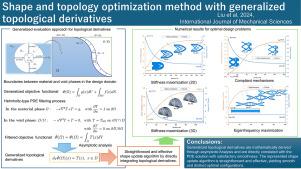Shape and topology optimization method with generalized topological derivatives
IF 7.1
1区 工程技术
Q1 ENGINEERING, MECHANICAL
International Journal of Mechanical Sciences
Pub Date : 2024-09-19
DOI:10.1016/j.ijmecsci.2024.109735
引用次数: 0
Abstract
This paper introduces a novel method for shape and topology optimization based on a generalized approach for evaluating topological derivatives, which are essential for the integration of shape and topology optimization. Traditionally, evaluating these derivatives presents significant mathematical challenges due to the discontinuity introduced by the insertion of a hole within the domain of interest. To overcome this issue, the study employs Helmholtz-type partial differential equations (PDEs) to construct a filtered objective functional. This approach ensures differentiability across the material and void phases and continuity over the fixed design domain while maintaining the same evaluation value as the original objective functional. By considering differentiability, continuity conditions, and the relationship between shape and topological derivatives during asymptotic analysis, generalized topological derivatives are obtained through established mathematical procedures. These topological derivatives exhibit a direct correlation with the PDE solutions and demonstrate satisfactory smoothness, thereby facilitating refined shapes in optimization strategies. Furthermore, an effective shape update algorithm is proposed, which directly integrates topological derivatives into structural optimization problems, simplifying their implementation and improving efficiency. Finally, the efficacy of the proposed methodology is demonstrated through its application to various optimal design problems, including stiffness maximization, compliant mechanisms, and eigenfrequency maximization. Verification results further highlight its potential to enhance existing methods for addressing more practical and complex optimization challenges.

使用广义拓扑导数的形状和拓扑优化方法
本文介绍了一种新颖的形状和拓扑优化方法,该方法基于拓扑导数评估的通用方法,拓扑导数对于形状和拓扑优化的整合至关重要。传统上,由于在感兴趣的域内插入一个孔会带来不连续性,因此评估这些导数会带来巨大的数学挑战。为了克服这一问题,本研究采用了亥姆霍兹型偏微分方程(PDE)来构建过滤目标函数。这种方法确保了材料阶段和空隙阶段的可微分性以及固定设计域的连续性,同时保持了与原始目标函数相同的评估值。在渐近分析过程中,通过考虑可微分性、连续性条件以及形状导数和拓扑导数之间的关系,可以通过既定的数学程序获得广义拓扑导数。这些拓扑导数与 PDE 解直接相关,并表现出令人满意的平滑性,从而有助于优化策略中的精细形状。此外,还提出了一种有效的形状更新算法,该算法将拓扑导数直接整合到结构优化问题中,简化了实施过程并提高了效率。最后,通过应用于各种优化设计问题,包括刚度最大化、顺从机构和特征频率最大化,证明了所提方法的有效性。验证结果进一步凸显了该方法在增强现有方法以应对更实际、更复杂的优化挑战方面的潜力。
本文章由计算机程序翻译,如有差异,请以英文原文为准。
求助全文
约1分钟内获得全文
求助全文
来源期刊

International Journal of Mechanical Sciences
工程技术-工程:机械
CiteScore
12.80
自引率
17.80%
发文量
769
审稿时长
19 days
期刊介绍:
The International Journal of Mechanical Sciences (IJMS) serves as a global platform for the publication and dissemination of original research that contributes to a deeper scientific understanding of the fundamental disciplines within mechanical, civil, and material engineering.
The primary focus of IJMS is to showcase innovative and ground-breaking work that utilizes analytical and computational modeling techniques, such as Finite Element Method (FEM), Boundary Element Method (BEM), and mesh-free methods, among others. These modeling methods are applied to diverse fields including rigid-body mechanics (e.g., dynamics, vibration, stability), structural mechanics, metal forming, advanced materials (e.g., metals, composites, cellular, smart) behavior and applications, impact mechanics, strain localization, and other nonlinear effects (e.g., large deflections, plasticity, fracture).
Additionally, IJMS covers the realms of fluid mechanics (both external and internal flows), tribology, thermodynamics, and materials processing. These subjects collectively form the core of the journal's content.
In summary, IJMS provides a prestigious platform for researchers to present their original contributions, shedding light on analytical and computational modeling methods in various areas of mechanical engineering, as well as exploring the behavior and application of advanced materials, fluid mechanics, thermodynamics, and materials processing.
 求助内容:
求助内容: 应助结果提醒方式:
应助结果提醒方式:


